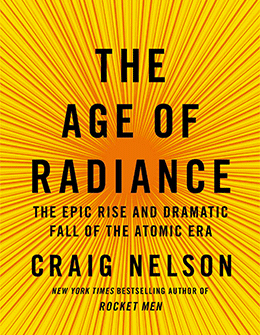By Jay M. Pasachoff
The Age of Radiance takes us on an interesting journey from the discovery of x-rays by Röntgen and radioactivity by Becquerel in the 19th century through the work (and providing the name radioactivity) of Marie Curie, and on to the present.
Marie Curie’s story is told in particular personal detail, and the story is fascinating, from her work and her life with Pierre, through her independent work after his death, and up to the Nobel Prize for her daughter Irène and Irène’s husband for the discovery of artificial radiation.
A following chapter starts with 1938, centered on Enrico Fermi, and then dealing with the Hungarian exiles, including Szilard, Wigner, Teller and others. The story of how Szilard recruited Einstein to write first to the Queen of Belgium and eventually to FDR is told in interesting detail. Lise Meitner, who figured out fission after her exile from Germany (and Nelson describes how the Jewish scientists were exiled), gets the credit she deserves—from the book, if not from her erstwhile collaborator, Hahn.
The 100-plus pages of Part II: The New World, takes us to the United States and the Manhattan project (recently the subject of a fictionalized serial on WGN-TV). The familiar story is well told, with can’t-put-the-book-down detail.
Part III takes us to the years of the cold war, with extensive coverage of the Oppenheimer hearings; I remain shocked that so few of my Astronomy 101 students have heard of J. Robert Oppenheimer—and, no doubt, of others who make up the backbone of this book. The book could and should be read by many, including all undergraduates as part of their general education.
The final part of the book is much more downbeat than the preceding 300 pages. It deals with problems of the atomic age, including the Three Mile Island event (which, as everyone should know, didn’t kill anybody directly and wound up doing much less harm than the coal/oil/gas power that replaced it and other non-built nuclear plants) and the devastating Chernobyl explosion. We read about the nuclear test ban, which has held for decades, though this week’s newspapers have described unfortunate cracks in the US-Russia limitation on intermediate-range missiles.
Nelson winds up his story with extensive treatment of the Fukushima earthquake and tsunami, its consequences, and how “those resonant images live on in our memories.” Nelson concludes, first quoting a physicist: “‘As they say in nuclear engineering, if the first use of gasoline had been to make napalm, we’d all be driving electric cars now.’ Nuclear’s invisible powers, mythic history, and scientific mysteries add up to inspire in the general public a belief in magic—black magic…. It’s hard to know which would horrify the nuclear science laureates profiled in this book more: their degraded reputations, or that their hard-earned science had been transformed into a collection of myths.” Nelson has continued a discussion earlier carried out so well in Spencer Weart’s Nuclear Fear. Nelson adds, “After seven decades, it is humankind’s responsibility to use the two-faced miracle discovered by Curie, Meitner, Fermi, Szilard, Teller, and Ulam correctly, not turn away from it in fear, superstition, and ignorance…. It is time to learn to live with blessed curses.”
To his credit (and his publisher’s), Nelson provides notes, bibliography, and an index in addition to an eight-page section of black-and-white photos, with Röntgen, Pierre and Marie Curie, and Iréne Curie with Frédéric Joliot on the section’s first page, and, in horrible contrast, Three Mile Island, Chernobyl, and Fukushima on the section’s last page.
Everyone with a yen to be generally educated should read this very readable book, become acquainted or reacquainted with the brilliant personalities described therein, and ponder the pros and cons of the nuclear age. I am moved to read Nelson’s prior book Rocket Men next.
Astronomer and author Jay Pasachoff is the director of Hopkins Observatory and Field Memorial Professor of Astronomy at Williams College.




